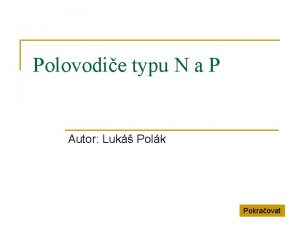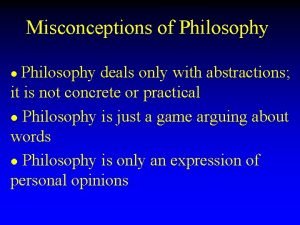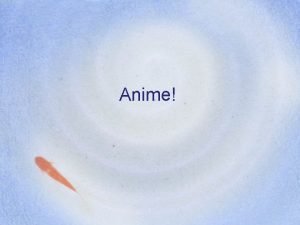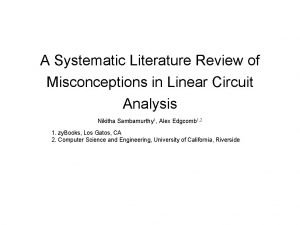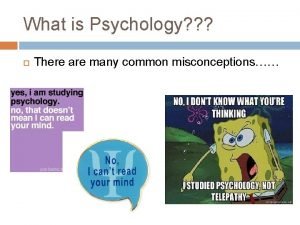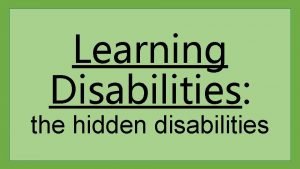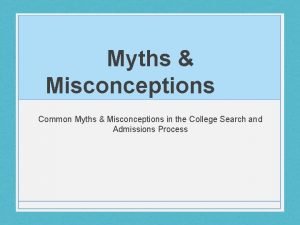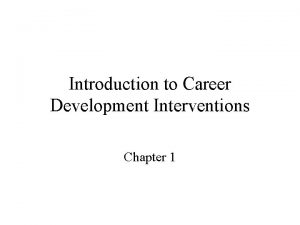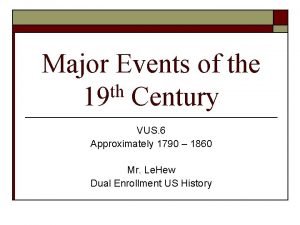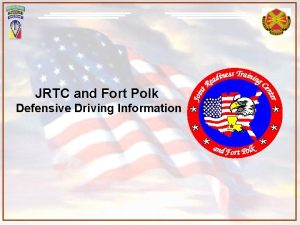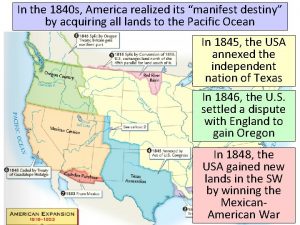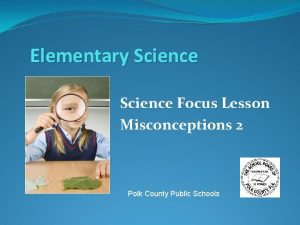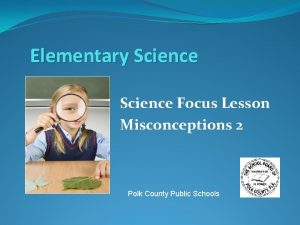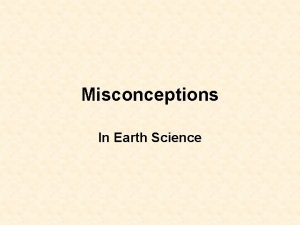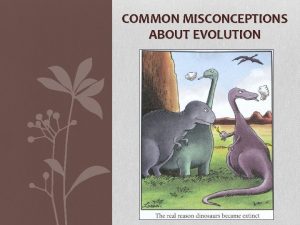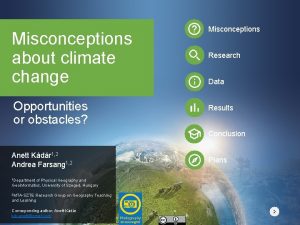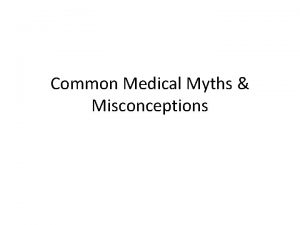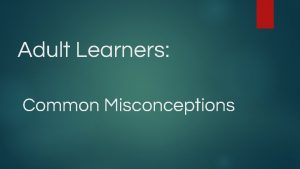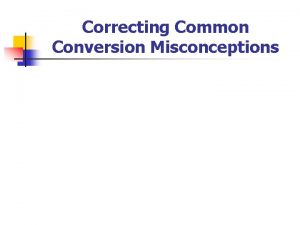Elementary Science Focus Lesson Misconceptions 1 Polk County
































- Slides: 32

Elementary Science Focus Lesson Misconceptions 1 Polk County Public Schools

Essential Question: How can science concepts help to clarify misconceptions? Vocabulary: dissolve solution melt vibration balanced force evaporate

Aristotle In 384 BCE, Aristotle was born in ancient Greece. He was interested in what could be learned directly from the physical world. Aristotle looked for answers to questions about many things and came up with an early theory about what matter is made of.

Where does matter go when it DISSOLVES? When one substance dissolves in another it forms a solution. Solutions are particles that are mixed up in a completely even distribution. Solutions can be solids dissolved in liquids. They can also be gases dissolved in liquids (such as carbonated water). There can also be gases in other gases and liquids in liquids. If you mix things up and they stay at an even distribution, it is a solution. When one substance dissolves in another substance it HAS NOT DISAPPEARED! Rather, the substances are spread out so evenly that you cannot tell one from the other. For more information go to this link http: //www. chem 4 kids. com/files/matter_solution. html

Where does water go when it EVAPORATES? Liquid water evaporates when energy is added. As it evaporates it becomes water vapor, the gaseous form of water, and goes into the surrounding atmosphere. This raises the humidity level a little bit. The atmosphere always holds some water vapor. When the air gets cooler, water vapor changes to tiny droplets of liquid water, this change is called condensation. Water droplets clump together to form clouds. Water vapor may not end up in a cloud, the water vapor forms a solution with the surrounding atmosphere when it evaporates…. IT IS ALL AROUND US! Check out this site http: //www. chem 4 kids. com/files/matter_gas. html

Are MELTING and DISSOLVING the same? Matter changes from one state to another when heat energy is added or subtracted. MELTING occurs when enough heat energy is added to change a SOLID into a LIQUID. DISSOLVING is NOT a change of state and NOT due to additional energy. Dissolving occurs when one substance spreads out evenly in another substance. Melting and dissolving are very different from one another. Melting is a change of state and dissolving is the forming of a special kind of mixture! Here is a fun site http: //www. bbc. co. uk/schools/scienceclips/ages/9_10/changing_state. shtml

Is GAS a form of matter? Matter is anything that has mass and takes up space. Matter is made of particles. Matter can be identified by its unique properties. Gas has mass-compare the mass of an inflated balloon with the mass of an empty balloon. Gas takes up space-observe the shape of a balloon which has been blown up with air! Gas is made up of particles which are spread out as much as possible, think about how the carbon dioxide gas dissolved in soda quickly escapes when the top is removed. Gases have different properties. Some, like air, are invisible. Chlorine gas is yellowish-green. Gas IS matter!! It may often be invisible, but it is there blowing up balloons, carbonating sodas, fueling grills, glowing in neon signs… Check out this link http: //www. chem 4 kids. com/files/matter_gas. html

Summarizing Think…Pair…Share Where does water go when it dissolves? Where does water go when it evaporates? What happens when solids melt? What evidence is there that gas is matter?

Thomas Edison was born in the mid 1800 s. He was a tireless inventor. Edison is known for his inventions involving energy transformations. He invented the phonograph for recording and replaying sound, improved the telephone, invented the incandescent light bulb, invented systems for making and showing motion pictures, and marketed the first alkaline batteries!

How is HEAT transferred? Heat energy always moves from a warmer object or area to a cooler object or area. Heat from a hot pot can burn your hand. The heat from your hand can melt an ice cube. If you open a door in the summer, heat from the hot air outside moves inside your air conditioned house. Heat moves in 3 ways: 1. Conduction is the movement of heat between objects that touch one another 2. Convection is the movement of heat energy through liquids and gases in currents 3. Radiation is how heat energy moves through space No matter how it is transferred, heat always goes FROM HOT to COLD! Try this interactive website http: //www. wisconline. com/Objects/View. Object. aspx? ID=SCE 304

What is needed to produce sound? Sound is a form of energy produced by vibrating OBJECTS. When you hum, your vocal cords vibrate. When you play a drum, the drumhead vibrates When you play a guitar, the strings vibrate. Different pitches can be produced by changing the rate of the vibrations High pitches are produced by faster vibrations Low pitches are produced by slower vibrations Different volumes can be produced by changing the size of the vibrations Louder sounds are created by larger vibrations Quieter sounds are created by smaller vibrations Sound can only be produced if there is MATTER to vibrate! Learn more about sound http: //www. historyforkids. org/scienceforkids/physics/sound/

Can sound travel through space? Sound vibrations make particles of the air around them vibrate. The vibrating air particles bump against other air particles and make them vibrate. Sound vibrations travel outward in all directions. If someone is nearby, vibrating air particles will hit the person’s eardrums and make them vibrate. The vibrations are passed long the nerves to the person’s brain and NOW THEY CAN HEAR THE SOUND!! Speed of Sound can ONLY travel where there is matter. There is NO air in outer space; that means that there is NO SOUND in outer space! Matter Speed (m/s) Air 340 Water 1, 500 Wood 4, 200 Iron 5, 100 Watch a model of sound vibrations traveling http: //science. howstuffworks. com/humans-hear-in-space 1. htm

Sir Isaac Newton was born in England in the 1600’s. He used math to explain the forces that govern the universe. Sir Isaac Newton is well known for describing the Universal Law of Gravitation and the Three Laws of Motion.

Do heavy objects fall faster than light objects? Gravity is the force that pulls objects toward each other. . All objects produce a force of gravity. The more mass an object has, the greater its force of gravity. Earth’s gravity pulls objects down to Earth. The Sun’s gravity keeps the planets and other objects in the solar system in orbit. All objects fall to the ground at the same rate…a bowling ball and a marble falling off a tall building at the same time would hit the ground at the SAME TIME! Watch this explanation about the force of gravity http: //www. youtube. com/watch? v=CUex. Ah. Ucx_8 Bill Nye can explain about gravity http: //www. youtube. com/watch? v=h. Zi 8 TXt. RRYg&feature=related

Is a force necessary to keep objects moving? Objects have a tendency to resist change in motion. NO NEW FORCES are need for… …objects to continue to stay still …objects to continue to move in a straight line …objects to continue to move at a constant speed This tendency is called INERTIA Balanced forces do NOT cause a change in motion Satellites or a space shuttle do not need added force to continue to orbit the Earth; the Earth does not need force to continue to revolve around the Sun Forces are NOT necessary in order to keep objects moving; forces are only necessary to CHANGE the motion of objects Read more about forces http: //www. physics 4 kids. com/files/motion_force. html

What is attracted to a magnet? There are many different kinds of metals: aluminum, copper, gold, iron, lead, mercury, nickel, platinum, silver, tin, titanium, zinc… A magnet is a material that produces an invisible magnetic field. This magnetic field exerts an invisible force that attracts certain materials. Only CERAIN metals are attracted to iron. Irons pull strongly on iron and steel. Steel is a mixture of iron and other metals. Most metals, like aluminum and copper, are not attracted to magnets. Only iron and a few other magnetic materials are attracted to a magnet. Learn more about magnetism at http: //www. physics 4 kids. com/files/elec_magneticfield. html

Summarizing The most important thing Pair Share: A tell B what the most important thing is that you learned from this lesson…why? B tell A what the most important thing is that you learned from this lesson…why?

Guided Instruction: 1. Dani adds 10 grams (g) of salt to a jar of water. She then adds 10 g of sand to a second jar of water. She covers and shakes both jars and sets them on the table for five minutes. The materials Dani used are shown below. What should Dani expect to observe after those five minutes? a. Both the salt and sand dissolved in the water. b. Both the salt and the sand settled to the bottom of the jar. c. The salt settled to the bottom of the jar, and the sand dissolved in the water. d. The salt dissolved in the water, and the sand settled to the bottom of the jar.

The answer is D When matter dissolves in water it forms a solution and spreads out so that you cannot tell one substance from another. Salt will form a salt water solution when mixed with water, sand does not dissolve in water and will sink to the bottom.

Guided Instruction: 2. Matter can undergo changes. When water boils, a ______. a. b. c. d. gas becomes a liquid solid becomes a liquid becomes a gas becomes a solid

The answer is When enough heat energy is added to liquid water it begins to boil. As it boils, the liquid water turns into a gas. The bubbles that form are water vapor!

Guided Instruction: 3. Which property of matter can be used to easily separate aluminum cans from steel cans at a recycling center? a. b. c. d. chemical thermal magnetic electric

The answer is Each type of matter has unique properties. Only some metals are attracted to a magnet. Steel is attracted to a magnet, aluminum is NOT. Therefore, steel in a recycling center will be attracted to a magnet while the aluminum is left behind, this can be a simple way to separate the cans!

Guided Instruction: 4. What does gravity do to objects on Earth? a. Gravity gives objects on Earth mass. b. Gravity causes objects on Earth to float. c. Gravity creates colors. d. Gravity pulls objects on Earth towards the surface.

The answer is Gravity is the force that pulls objects toward each other. The strength of the Earth’s gravity pulls objects on Earth toward the surface.

Summarizing Talking Chips One at a time, each team mate tell the others what science finding surprises you the most!

Check Your Understanding 1. Kate had two cups of water. She added a tablespoon of sugar to one cup and mixed it. She put a tablespoon of sand in the second cup and mixed it. What happened to the sugar and sand when Kate mixed them with water? a. b. c. d. The sand dissolved forming a solution; the sugar did not dissolve. The sand dissolved forming a solution; the sugar evaporated. The sugar dissolved forming a solution; the sand did not dissolve. The sugar melted; the sand did not melt.

Check Your Understanding 2. When water molecules evaporate into vapor, what happens to the mass of the water vapor? The water vapor mass is heavier which is why it condenses. b. The mass of the water vapor is less since it weighs less. c. The water vapor has no mass because it evaporates. d. The mass of the water vapor is the same as the mass of a. the water from which it came.

Check Your Understanding 3. A flute makes a higher pitch sound than a trumpet, and a trumpet makes a higher pitch sound than a tuba. Which of the following statements would be true? the flute produces the lowest frequency of sound wave b. the trumpet produces the lowest frequency of sound waves c. the tuba produces the lowest frequency of sound waves d. the tuba produces the highest frequency of sound waves a.

Check Your Understanding 4. Jason stretches a rubber band between his fingers, as shown below. When he plucks the rubber band, it makes a sound. Which of the following best explains why the rubber band makes a sound when Jason plucks it? It heats the air. b. It vibrates the air. c. It absorbs energy from the air. d. It releases molecules into the air. a.

Check Your Answers 1. c-sugar can dissolve in water, sand cannot 2. d-the mass of a quantity of matter remains the same, even when the matter changes state 3. c-lower pitched sounds are produced from slower vibrations, lower frequency means slower vibrations 4. b-a sound can be heard when the vibrations vibrate the air which then vibrates ear drums

Summary Question Pair Share What science question would you like to have answered? Why?
 Common misconceptions about computer science
Common misconceptions about computer science Polk county gis map viewer
Polk county gis map viewer Polk county parcel map
Polk county parcel map Polk hub telestaff
Polk hub telestaff Polk county gis
Polk county gis Polk county gis
Polk county gis Polk county moodle
Polk county moodle Prolepsis
Prolepsis Cost focus and differentiation focus
Cost focus and differentiation focus Differentiation cost leadership
Differentiation cost leadership Actor focus vs object focus
Actor focus vs object focus Aristotle and galileo views of motion venn diagram
Aristotle and galileo views of motion venn diagram Common misconceptions about philosophy
Common misconceptions about philosophy Naruto anime outline
Naruto anime outline Misconceptions about literature review
Misconceptions about literature review Common psychology misconceptions
Common psychology misconceptions Misconceptions about learning disabilities
Misconceptions about learning disabilities Misconceptions of multicultural education
Misconceptions of multicultural education Common college misconceptions
Common college misconceptions Competence vs performance in linguistics
Competence vs performance in linguistics Introduction to career development
Introduction to career development My favourite subject worksheet
My favourite subject worksheet Lesson 1 understanding science answer key
Lesson 1 understanding science answer key James k polk
James k polk Ar 385-55
Ar 385-55 James k polk
James k polk Davis polk
Davis polk James k polk
James k polk Cynthia polk johnson
Cynthia polk johnson Polk's war plan
Polk's war plan Dcfs stipend program
Dcfs stipend program Brittany polk
Brittany polk Polk state orientation
Polk state orientation





